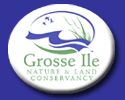

What kind of herbicide do you use on phragmite and how do you administer it?
by Bruce JonesFirst, phragmites is an alien, invasive species from Europe and Asia that is literally taking over our wetlands. To our knowledge, it arrived in the 1800's and has now hybridized with a native phragmites. You find it along most roads now in the drainage ditches and in most of our wetlands. It is a major headache!! It grows so densely that no other native plants can survive in it. It also sends up so many stiff shoots that the density stops all wildlife but a few insects from using it. It also changes the soil chemistry to one not appreciated by native plants. It spreads by underground roots, seeds (which are not very fertile) and surface runners. The Grosse Ile Nature & Land Conservancy (GINLC) has pictures of a 40 foot surface runner with a root - stem node every 9 inches. While it originally was a wetland plant and still prefers wetlands, it has also adjusted now to grow in drier areas.
Large areas almost require professional control. Our most effective control for smaller patches is to shock the plant by repeated cutting of the stems beginning when they are about a foot high beginning in the spring. After repeated cutting all summer, we spray the area with a concentrated glyphosate ( we use Round-Up) usually in September when the plants are going into their winter condition. Although still diluted, we use the Roundup in a stronger concentration than the routine dilution. In larger plots, we spray with a tank sprayer. In smaller plots, we us a hand held bottle sprayer like a used Windex bottle. In the following spring, we respray when the remaining plants are about a foot high. Roundup kills everything so it must be used with caution.
On small areas, we cut the stem and then soak the cut stem with Round Up using a hand held bottle sprayer. We also have developed a dauber composed of 1 inch diameter PVC pipe with a valve near the end and a sponge at the end.
Even though phragmites may not return the following year, the area needs constant monitoring. The GINLC eliminated the phragmites along the Nature Area shore in 2002 and 2003 before replanting it with native species. Isolated shoots of phragmites have popped up this year and we are using the cut and daub approach because of the native plants surrounding it.
The State of Michigan DEQ has published the following guide:
A Landowner's Guide to Phragmites ControlClick here for additional useful information on Phragmites control.